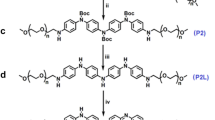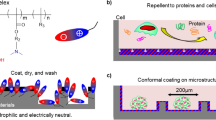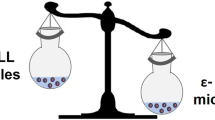Abstract
In this study, a novel polymer material was introduced into cells and was delivered to specific organelles. Various fluorescently labeled copolymers of 2-methacryloyloxyethylphosphorylcholine (MPC) and alkyl methacrylates, such as n-hexyl methacrylate (HMA), n-dodecyl methacrylate (DMA) and stearyl methacrylate (SMA), were synthesized. HeLa cells were treated with the copolymers and subsequently observed by confocal fluorescence microscopy. The results indicated that the localization behavior of the copolymers was dependent on their structure. For instance, poly(HMA-co-MPC) was non-cytotoxic and was localized in specific cellular organelles such as the endoplasmic reticulum. In contrast, poly(DMA-co-MPC) was cytotoxic and was partially transported to specific organelles. Poly(SMA-co-MPC) hardly entered the cells. The mechanism of delivery and structure–function relationships of the copolymers are also discussed.
Similar content being viewed by others
Log in or create a free account to read this content
Gain free access to this article, as well as selected content from this journal and more on nature.com
or
References
Hoffman, A. S. The origins and evolution of ‘controlled’ drug delivery systems. J. Control Release 132, 153–163 (2008).
Jung, J., Kasuya, T., Tanizawa, K. & Kuroda, S. Bionanocapsules for in vivo pinpoint drug delivery. Yakugaku Zasshi 127, 797–804 (2007).
Igarashi, R., Takenaga, M. & Matsuda, T. Distribution of lipid microsphere preparations. Adv. Drug Deliv. Rev. 20, 147–154 (1996).
Mizushima, Y. Lipid microspheres (lipid emulsions) as drug carrier - an overview. Adv. Drug Deliv. Rev. 20, 113–115 (1996).
Hirayama, F. & Uekama, K. Cyclodextrin-based controlled drug release system. Adv. Drug Deliv. 36, 125–141 (1999).
Minko, T. Drug targeting to the colon with lectins and neoglycoconjugates. Adv. Drug Deliv. Rev. 56, 491–509 (2004).
Maeda, H., Greish, K. & Fang, J. The enhanced permeability and retention effect and polymeric drugs: a paradigm shift for cancer chemotherapy in the 21st century. Adv. Polym. Sci. 193, 103–121 (2006).
Satchi-Fainaro, R., Duncan, R. & Barnes, C. M. Polymer therapeutics for cancer: current status and future challenges. Adv. Polym. Sci. 193, 1–65 (2006).
Bae, Y., Fukushima, S., Harada, A. & Kataoka, K. Design of environment-sensitive supramolecular assemblies for intracellular drug delivery: polymeric micelles that are responsive to intracellular pH change. Angew. Chem. Int. Ed. 42, 4640–4643 (2003).
Wu, P. C., Wang, W. S., Huang, Y. T., Sheu, H. S., Lo, Y. W., Tsai, T. L., Shieh, D. B. & Yeh, C. S. Porous iron oxide based nanorods developed as delivery nanocapsules. Chem. Eur. J. 13, 3878–3885 (2007).
Sethuraman, V. A. & Bae, Y. H. TAT peptide-based micelle system for potential active targeting of anti-cancer agents to acidic solid tumors. J. Control Release 118, 216–224 (2007).
Kobayashi, T., Ishida, T., Okada, Y., Ise, S., Harashima, H. & Kiwada, H. Effect of transferrin receptor-targeted liposomal doxorubicin in P-glycoprotein-mediated drug resistant tumor cells. Int. J. Pharm. 329, 94–102 (2007).
Roy, I., Ohulchanskyy, T. Y., Bharali, D. J., Pudavar, H. E., Mistretta, R. A., Kaur, N. & Prasad, P. N. Optical tracking of organically modified silica nanoparticles as DNA carriers: a nonviral, nanomedicine approach for gene delivery. Proc. Natl. Acad. Sci. USA 102, 279–284 (2005).
Arnedo, A., Irache, J. M., Merodio, M. & Espuelas Millán, M. S. Albumin nanoparticles improved the stability, nuclear accumulation and anticytomegaloviral activity of a phosphodiester oligonucleotide. J. Control Release 94, 217–227 (2004).
Jing, N., Xiong, W., Guan, Y., Pallansch, L. & Wang, S. Potassium-dependent folding: a key to intracellular delivery of G-quartet oligonucleotides as HIV inhibitors. Biochemistry 41, 5397–5403 (2002).
Brokx, R. D., Bisland, S. K. & Gariépy, J. Designing peptide-based scaffolds as drug delivery vehicles. J. Control Release 78, 115–123 (2002).
Kamiya, H., Tsuchiya, H., Yamazaki, J. & Harashima, H. Intracellular trafficking and transgene expression of viral and non-viral gene vectors. Adv. Drug Deliv. Rev. 52, 153–164 (2001).
Tomlinson, E. & Rolland, A. P. Controllable gene therapy pharmaceutics of non-viral gene delivery systems. J. Control Release 39, 357–372 (1996).
Little, S. R. & Kohane, D. S. Polymers for intracellular delivery of nucleic acids. J. Mater. Chem. 18, 832–841 (2008).
Fuller, J. E., Zugates, G. T., Ferreira, L. S., Ow, H. S., Nguyen, N. N., Wiesner, U. B. & Langer, R. S. Intracellular delivery of core–shell fluorescent silica nanoparticles. Biomaterials 29, 1526–1532 (2008).
Liu, L., Guo, K., Lu, J., Venkatraman, S. S., Luo, D., Ng, K. C., Ling, E. A., Moochhala, S. & Yang, Y. Y. Biologically active core/shell nanoparticles self-assembled from cholesterol-terminated PEG–TAT for drug delivery across the blood–brain barrier. Biomaterials 29, 1509–1517 (2008).
Dhar, S., Liu, Z., Thomale, J., Dai, H. & Lippard, S. J. Targeted single-wall carbon nanotube-mediated Pt(IV) prodrug delivery using folate as a homing device. J. Am. Chem. Soc. 130, 11467–11476 (2008).
Ko, I. K., Ziady, A., Lu, S. & Kwon, Y. J. Acid-degradable cationic methacrylamide polymerized in the presence of plasmid DNA as tunable non-viral gene carrier. Biomaterials 29, 3872–3881 (2008).
Selvi, B. R., Jagadeesan, D., Suma, B. S., Nagashankar, G., Arif, M., Balasubramanyam, K., Eswaramoorthy, M. & Kundu, T. K. Intrinsically fluorescent carbon nanospheres as a nuclear targeting vector: delivery of membrane-impermeable molecule to modulate gene expression in vivo. Nano Lett. 8, 3182–3188 (2008).
Huang, X., Meng, X., Tang, F., Li, L., Chen, D., Liu, H., Zhang, Y. & Ren, J. Mesoporous magnetic hollow nanoparticles - protein carriers for lysosome escaping and cytosolic delivery. Nanotechnology 19, 445101–445108 (2008).
Gomes, A. J., Faustino, A. S., Lunardi, C. N., Lunardi, L. O. & Machado, A. E. H. Evaluation of nanoparticles loaded with benzopsoralen in rat peritoneal exudate cells. Int. J. Pharm. 332, 153–160 (2007).
Smith, R. A. J., Porteous, C. M., Gane, A. M. & Murphy, M. P. Delivery of bioactive molecules to mitochondria in vivo. Proc. Natl. Acad. Sci. USA 100, 5407–5412 (2003).
Yoshikawa, T., Okada, N. & Nakagawa, S. Development of intracellular drug delivery system using fusogenic liposome. Yakugaku Zasshi 127, 789–796 (2007).
Anderson, K., Creswell, P., Gammon, M., Hermes, J., Williamson, A. & Zweerink, H. Endogenously synthesized peptide with an endoplasmic reticulum signal sequence sensitizes antigen processing mutant cells to class I-restricted cell-mediated lysis. J. Exp. Med. 174, 489–492 (1991).
Wei, M. L. & Creswell, P. HLA-A2 molecules in an antigen-processing mutant cell contain signal sequence-derived peptides. Nature 356, 443–446 (1992).
Ueda, T., Oshida, H., Kurita, K., Ishihara, K. & Nakabayashi, N. Preparation of 2-methacryloyloxyethyl phosphorylcholine copolymers with alkyl methacrylates and their blood compatibility. Polym. J. 24, 1259–1269 (1992).
Ishihara, K., Ueda, T. & Nakabayashi, N. Preparation of phospholipid polymers and their properties as polymer hydrogel membranes. Polym. J. 22, 355–360 (1990).
Kojima, R., Kasuya, M. C. Z., Ishihara, K. & Hatanaka, K. Synthesis of amphiphilic copolymers by soap-free interface-mediated polymerization. Polym. J. 41, 370–373 (2009).
Ríos-Martin, J. J., Díaz-Cano, S. J. & Rivera-Hueto, F. Ultrastructural distribution of lectin-binding sites on gastric superficial mucus-secreting epithelial cells. Histochemistry 99, 181–189 (1993).
Vetterlein, M., Ellinger, A., Neumüller, J. & Pavelka, M. Golgi apparatus and TGN during endocytosis. Histochem. Cell Biol. 117, 143–150 (2002).
Alberts, B., Bray, D., Lewis, J., Raff, M., Roberts, K. & Watson, J. D. in Molecular Biology of the Cell 3rd edn, 551 (Garland Publishing Inc., New York, 1994, ).
Helenius, A. & Simons, K. Solubilization of membranes by detergents. Biochim. Biophys. Acta. 415, 29–79 (1975).
Bianchi, V. & Fortunati, E. Cellular effects of an anionic surfactant detected in V79 fibroblasts by different cytotoxicity tests. Toxicol. Vitro. 4, 9–16 (1990).
Benoit, J., Cormier, M. & Wepierre, J. Effect of proteins on the assessment of surfactant cytotoxicity by an in vitro test: possible correlations with in vivo data. Toxicol. Vitro. 1, 91–96 (1987).
Acknowledgements
We acknowledge Professor Hiroyuki Aburatani and Dr Akira Watanabe of the Genome Science Division, Research Center for Advanced Science and Technology, The University of Tokyo for performing the confocal fluorescence microscopy. This work was supported by a grant for the Development of Novel Diagnostic and Medical Applications through Elucidation of Sugar Chain Functions from the New Energy and Industrial Technology Development Organization.
Author information
Authors and Affiliations
Corresponding author
Ethics declarations
Competing interests
The authors declare no conflict of interest.
Rights and permissions
About this article
Cite this article
Kojima, R., Kasuya, M., Ishihara, K. et al. Physicochemical delivery of amphiphilic copolymers to specific organelles. Polym J 43, 718–722 (2011). https://doi.org/10.1038/pj.2011.49
Received:
Revised:
Accepted:
Published:
Issue date:
DOI: https://doi.org/10.1038/pj.2011.49



